Myricetin induces M2 macrophage polarization to alleviate renal tubulointerstitial fibrosis in diabetic nephropathy via PI3K/Akt pathway
Wei-Long Xu,Pei-Pei Zhou,Xu Yu,Ting Tian,Jin-Jing Bao,Chang-Rong Ni,Min Zha,Xiao Wu,Jiang-Yi Yu
Abstract BACKGROUND Development of end-stage renal disease is predominantly attributed to diabetic nephropathy (DN).Previous studies have indicated that myricetin possesses the potential to mitigate the pathological alterations observed in renal tissue.Nevertheless,the precise molecular mechanism through which myricetin influences the progression of DN remains uncertain.AIM To investigate the effects of myricetin on DN and explore its potential therapeutic mechanism.METHODS Db/db mice were administered myricetin intragastrically on a daily basis at doses of 50 mg/kg or 100 mg/kg for a duration of 12 wk.Subsequently,blood and urine indexes were assessed,along with examination of renal tissue pathology.Kidney morphology and fibrosis were evaluated using various staining techniques including hematoxylin and eosin,periodic acid-Schiff,Masson’s trichrome,and Sirius-red.Additionally,high-glucose culturing was conducted on the RAW 264.7 cell line,treated with 25 mM myricetin or co-administered with the PI3K/Akt inhibitor LY294002 for a period of 24 h.In both in vivo and in vitro settings,quantification of inflammation factor levels was conducted using western blotting,real-time qPCR and ELISA.RESULTS In db/db mice,administration of myricetin led to a mitigating effect on DN-induced renal dysfunction and fibrosis.Notably,we observed a significant reduction in expressions of the kidney injury markers kidney injury molecule-1 and neutrophil gelatinase associated lipocalin,along with a decrease in expressions of inflammatory cytokinerelated factors.Furthermore,myricetin treatment effectively inhibited the up-regulation of tumor necrosis factoralpha,interleukin-6,and interluekin-1β induced by high glucose in RAW 264.7 cells.Additionally,myricetin modulated the M1-type polarization of the RAW 264.7 cells.Molecular docking and bioinformatic analyses revealed Akt as the target of myricetin.The protective effect of myricetin was nullified upon blocking the polarization of RAW 264.7 via inhibition of PI3K/Akt activation using LY294002.CONCLUSION This study demonstrated that myricetin effectively mitigates kidney injury in DN mice through the regulation of macrophage polarization via the PI3K/Akt signaling pathway.
Key Words: Myricetin;Diabetic nephropathy;PI3K/Akt pathway;Renal tubulointerstitial fibrosis;Macrophage;Polarization
INTRODUCTION
Diabetes mellitus (DM) is a major global public health concern that continues to increase in prevalence.Reportedly,there is an estimated 12.8% prevalence of diabetes in China,with a concerning trend of affecting younger generations[1,2].DM ranks as the third most detrimental chronic non-communicable disease to human health,trailing behind cancer and cardiovascular diseases.Moreover,DM patients commonly experience chronic hyperglycemia,a metabolic disorder that adversely affects multiple kidney cell types,ultimately leading to progressive kidney failure[3,4].Diabetic nephropathy (DN) is frequently observed as a chronic microvascular complication linked to end-stage renal disease (ESRD),and it constitutes a significant contributor to both disability and mortality[5].The clinical characteristics of DN include persistent proteinuria and the gradual decline of glomerular filtration rate.Additionally,DN patients commonly exhibit pathological alterations such as tubulointerstitial fibrosis and progressive glomerular damage[6,7].
The precise pathogenesis and progression of DN remain unclear.Existing evidence suggests that the metabolic disorder induced by hyperglycemia may initiate the excessive activation of multiple pathways,potentially leading to mechanical damage of renal tissue[4,8,9].Notably,inflammatory responses and the immune system play a crucial role in the progression of DN[10-12].Macrophages,famous for their pluripotency and plasticity,differentiate into classically activated (M1) cells and alternatively activated (M2) cells,playing opposing roles in the regulation of inflammation[13].M1 cells are closely associated with the proinflammatory response,and increased expressions of CD86,tumor necrosis factor-alpha (TNF-α) and inducible nitric oxide synthase (iNOS) represent the phenotype transformation of M1;whereas,M2 cells have increased expression of CD206,arginase-1 (Arg-1) and interleukin (IL)-10[14,15].More importantly,the above two distinct cell subsets exist in a dynamic balanced state.Indeed,one study has indicated that the regulation of macrophage polarization could inhibit renal inflammation in mice with DM[16].
The PI3K-Akt pathway serves a crucial function in the advancement of DN,not only in regulating cell survival and proliferation but also in facilitating the progression of DN.Recent findings have indicated that,in the presence of diabetic conditions,the inhibitory effect of the transcription coregulator YAP on PTEN leads to activation of the PI3K/Akt pathway.Consequently,this activation results in accumulation of nuclear YAP,thereby enhancing the proliferation of glomerular mesangial cells and contributing to the formation of DN[17].It has been reported that the wogonin flavonoid exhibited inhibitory effects on tubulointerstitial fibrosis and renal tubular cell injury in mouse models of streptozotocin (STZ)-induced diabetesviaPI3K/Akt/NF-κB signaling[18].
Currently,there is a limited availability of curative therapies for DN,and the effective prevention of renal failure progression caused by DN remains challenging.A significant proportion of ESRD patients who undergo long-term dialysis experience a high mortality rate,with approximately 20% of the population succumbing to this condition annually[19].The primary strategies for DN patients to delay renal injury involve the control of blood glucose levels,blood pressure,and lifestyle modifications.However,the efficacy of these interventions is notably restricted[20,21].As a result,there is an urgent need for new effective treatments to counter DM-associated kidney damage.
Abelmoschus Manihotcapsule,an important Chinese patent medicine and widely used in treating kidney diseases,consists of seven flavonoids,including rutin,hyperoside,quercetin,myricetin,hibifolin,isoquercetin,and quercetin-3-orobinobioside[22].Our studies have been devoted to examining the roles of the total flavones of Abelmoschus manihot[23],hyperoside[24] and quercetin[25] in animal models of DN.Myricetin,present in dicotyledonous plants,has demonstrated a wide range of medicinal properties including anti-inflammatory,anti-cancer,and hepatoprotective[26,27].For example,Parket al[28] found that 30 Mm of myricetin suppresses NF-κB activation and attenuates the secretion of TNF-α and IL-6.Liaoet al[29] found that myricetin prevented diabetic-associated cardiac injury in STZ-induced mice and in high glucose-challenged neonatal rat cardiomyocytes.These investigators also found that myricetin possesses a potential protective effect by inhibiting IκBα/NF-κB pathways and enhancing Nrf2/HO-1.Kandasamy and Ashokkumar[30] found that STZ-induced diabetic nephrotoxic rats treated with myricetin were protected from glomerular injury,further suggesting its potential as an anti-hyperglycemic agent.These data collectively indicate that myricetin has effects on inhibiting the secretion of inflammatory factors and its potential therapeutic functions on diabetic-related disease as well.However,the mechanism underlying how myricetin inhibits the progress of DN remains a mystery.
For the current study,db/db mice were used to explore the effects of myricetin in the progression of DN.The mouse RAW 264.7 cell line was then used to study the mechanism by which myricetin intervenes in high glucose-induced macrophage injury.Our results indicate that myricetin regulates the polarization of macrophages through mediating the phosphorylation of Akt,and thus participates in the progression of DN.
MATERIALS AND METHODS
Cell culture
In vitrostudies were carried out in the mouse RAW 264.7 cell line (American Type Culture Collection,Manassas,VA,United States),which was maintained in low glucose-Dulbecco's modified Eagle media supplemented with 100 U/mL penicillin,100 mg/mL streptomycin,and 10% fetal bovine serum inactivated by heat.The cells were grown at 37°C in a humidified atmosphere of 5% CO2.For experimentation,the cells were plated on a dish or in a microplate after trypsinization and incubated for 24 h before use.For the high-glucose treatments,glucose concentrations were adjusted to 5.5 mM,25 mM or 33.3 mM (the latter designated as ‘HG’).For the myricetin treatments,12.5 μM,25 μM or 50 μM were applied for 48 h before further analysis.LY294002 (Sigma-Aldrich,Merck KGaA,Darmstadt,Germany),an Akt phosphorylation inhibitor,was administered for selective inhibition of Akt activation.
Experimental animal models
Mice (6 wk of age) of the db/m and db/db genotypes were obtained from the Hangzhou Ziyuan experimental animal facility [SCXK (Zhe) 2019-0004].For the study period,the Experimental Animal Center of Jiangsu Provincial Hospital of Traditional Chinese Medicine (Jiangsu,China) housed all mice at 22°C with 12 h/12 h light/dark cycle,without restrictions on food or water intake.A 2-wk adaptation period with normal diet was allowed to all mice before experimental procedures were initiated.After another 4 wk of adaptive feeding,myricetin was administered to the db/db mice intragastrically at dosages of 50 mg/kg and 100 mg/kg every day.Positive controls included six db/db mice given the angiotensin II receptor blocker irbesartan (Sigma-Aldrich,Merck KGaA).All animals were subjected to weighing and serum and urine collection every 4 wk.At week 24,the mice were sacrificed for renal tissue collection.
In all experiments,guidelines provided by the National Institutes of Health (NIH,Bethesda,MD,United States) were followed.The study was carried out with approval by the Ethical Committee of Jiangsu Provincial Hospital of Traditional Chinese Medicine,in compliance with the guidelines for the Care and Use of Laboratory Animals [QK-20200408-001].
Histological examination
Collected renal tissue was initially fixed with a 4% paraformaldehyde solution for a duration of 24 h,after which it was embedded in paraffin.Subsequently,the tissue samples were sliced into sections with a thickness of 4 mm and subjected to staining using hematoxylin and eosin (HE),periodic acid-Schiff (PAS),Masson’s trichrome,and Sirius-red,respectively.Ten sections were chosen from every mouse and each was examined under light microscope at 100 × optical magnification.Histological changes were assessed at 200 × optical magnification.Brightfield images were acquired using an IX83 microscope (Olympus,Tokyo,Japan),and these images were subsequently analyzed using Image-Pro Plus software (Media Cybernetics,Rockville,MD,United States).Semi-quantitative analysis was performed to compare the samples from each group and a histogram was made.Representative renal images are presented from each group.
Flow cytometry
The cultured cells were washed and subsequently treated with CD16/CD32 antibodies to inhibit the activity of cell surface Fc receptors.Following this,the cells were stained using fluorescence-conjugated monoclonal antibodies,specifically APC-anti-CD206,PE-anti-CD86,and FITC-anti-F4/80 respectively (BioLegend,San Diego,CA,United States).The staining procedure was conducted for a duration of 20 min at room temperature in a dark environment,after which the samples were washed and analyzed using flow cytometry equipment from BD Biosciences (Franklin Lakes,NJ,United States).The data were analyzed using the FlowJo v10.8 software (Ashland,OR,United States).
Urine albumin-to-creatinine ratio measurement
Urinary albumin and creatinine levels were determined utilizing urinary albumin and creatinine testing kits,following the manufacturer's instructions (Jiancheng Bioengineering,Nanjing,Jiangsu,China).Urinary albumin was measured by immunoturbidimetry and creatinine by the sarcosine oxidase method.The urine albumin-to-creatinine ratio (uACR) measurement was calculated by dividing urinary albumin by urinary creatinine (μg/mg),which could be applied for detection,diagnosis and monitoring.The calibration of urine albumin by creatinine can effectively avoid the interference of other baseline factors such as body weight (BW) and food intake,and ensure comparability of the results.
Immunohistochemistry
A 30-min incubation of 5% bovine serum albumin was conducted on 5-mm sections of the kidney.Subsequently,the sections were incubated with primary antibodies overnight at 4°C.After washing,the slides were incubated with goat anti-rabbit IgG H&L antibody (Abcam,Cambridge,United Kingdom) for 60 min.Following this,a 1-min hematoxylin staining procedure was performed.Finally,the slides were mounted and observed under a microscope.
ELISA analysis
The concentration of each predicted mediator was quantified using commercially available ELISA kits obtained from Beyotime Biotech (Beijing,China),strictly following the manufacturer’s instructions.
Western blotting analysis
Cell lysates were extracted and separated by SDS-PAGE,and then transferred to polyvinylidene fluoride membranes (Millipore,Billerica,MA,United States) following protein concentration measurement.The blotted membranes were first blocked using fat-free milk and incubated overnight at 4°C with primary antibodies.Afterward,the membranes were washed with Tris-buffered saline-Tween and incubated with secondary antibodies.Results were detectedviaenhanced chemiluminescence (Applygen Technologies Inc,Beijing,China),and the densitometric data (based on the immunoreactive signals) were analyzed using open-source ImageJ software (https://imagej.net/ij/download.html).Protein levels were determined by calculating induction folds using the density ratio of the target protein to β-actin.The antibodies targeting kidney injury molecule-1 (Kim-1;Catalog No.sc-518008),neutrophil gelatinase associated lipocalin (NGAL;sc-515876),collagen-1a1 (Col1a1;sc-59772),alpha-smooth muscle actin (α-SMA;sc-53142),iNOS (sc-7271),Arg-1 (sc-166920),and others were purchased from Santa Cruz Biotechnology (Dallas,TX,United States).
qRT-PCR analysis
To determine the concentration of total RNA,Trizol reagent (Sigma-Aldrich,St Louis,MO,United States) was used following the manufacturer's instructions.The first strand of cDNA was synthesized using a reverse transcriptase enzyme (Life Technologies,Waltham,MA,United States).The relative levels of target genes were determined through reverse transcription-qPCR,as previously reported[31].Normalization to β-actin was carried out,and the 2-ΔΔCTmethod was utilized to calculate the relative levels of target genes.The primers used for real-time PCR (5’-3’) can be found in Table 1.
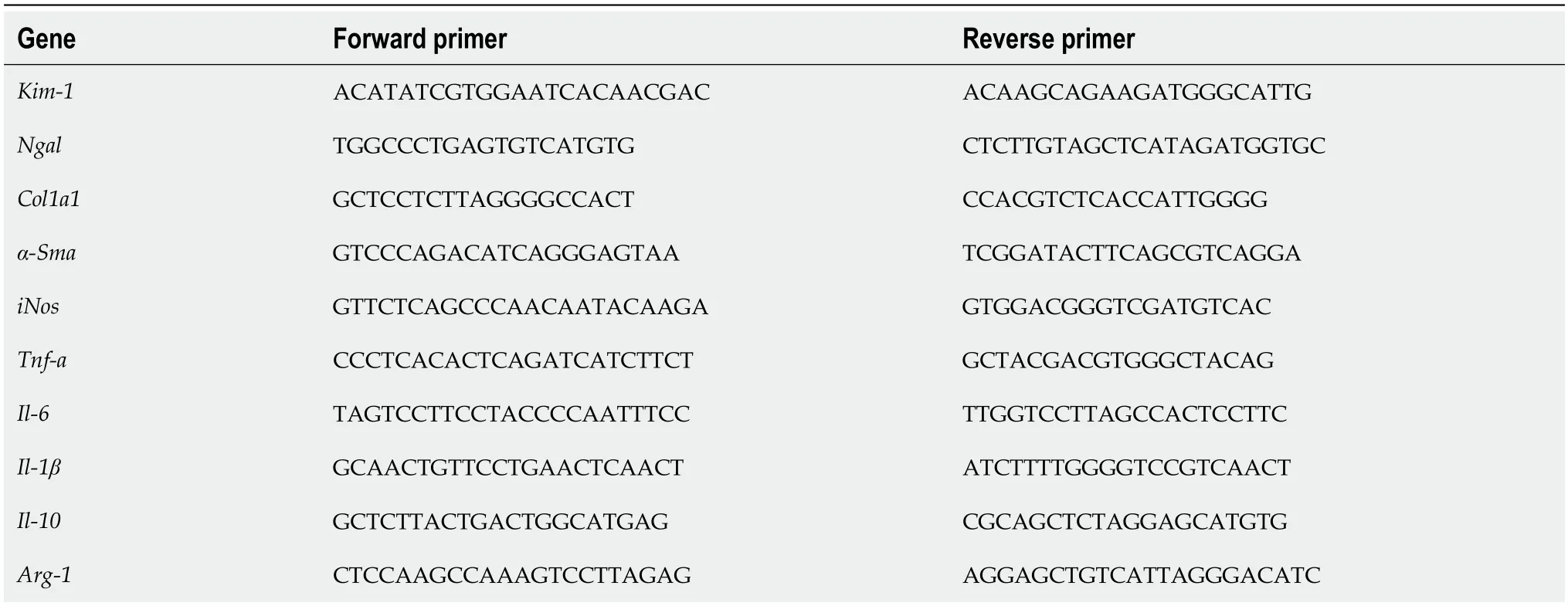
Table 1 Primers used in real-time PCR,5-3
Network pharmacology analysis
SwissTargetPrediction (http://www.SwissTargetPrediction.ch) was utilized for the purpose of predicting the structural similarity of anticipated targets based on the acquired formula.Concurrently,our disease-associated targets were obtained from GeneCards (https://www.genecards.org/) and Online Mendelian Inheritance in Man compendium (OMIM;https://www.OMIM.org/),with a specific focus on identifying targets related to "diabetic nephropathy".The target gene's name was matched by configuring the subject as "human" and employing the "Vlookup" function to filter genes that intersect with drugs and diseases.
DN and myricetin share numerous common targets,as evidenced by a Venn diagram generated using an online bioinformatics tool (http://www.bioinformatics.com.cn).To identify protein-protein interactions (PPIs),potential targets were entered into the STRING database (https://cn.string-db.org/),resulting in a visual PPI network constructed using Cytoscape 3.7.2.The degree value was then calculated to determine the key protein within the PPI network.Nodes within the network were color-coded and sized proportionally to their respective degree values,with larger and darker nodes indicating higher degree values.
Pathway enrichment analysis
The clusterProfiler,Stringin,DOSE,and Pathview programs were executed in the R language utilizing the bioinformatics open source platform Bioconductor (http://www.Bioconductor.org/).The visualization display was conducted through the WeChat letter platform.Gene Ontology (GO) bioinformatic analysis was used to elucidate the role of target proteins in drug therapy gene function,encompassing molecular function,cellular component,and biological process.In addition,Kyoto Encyclopedia of Genes and Genomes (KEGG) pathway enrichment analysis was conducted as a component of signal pathway enrichment analysis to identify drug therapy targets.
Macromolecular docking
Myricetin was subjected to docking with Akt and PI3K,respectively.The crystal structure file of the protein target was obtained from the Protein Data Bank (PDB) database in PDB format.In order to facilitate docking,the compounds of myricetin in SDF format were downloaded from PubChem (https://PubChem.ncbi.nlm.nih.gov/).Subsequently,virtual docking experiments were conducted using Autodock 4.2.6.It is important to note that docking solely alters the conformation of the ligand,while preserving the conformational changes of the protein and leaving all other parameters unchanged.The outcomes of the docking process were visualized using PyMOL 2.2.0 software (https://pymol.org/2/) and Discovery Studio Client v19.1.0 (https://discover.3ds.com/discovery-studio-visualizer-download).
Statistical analysis
A total of three repetitions of each experiment were performed,and the results were summarized as means and standard deviations.The statistical software SPSS 22.0 (IBM Corp,Armonk,NY,United States) was utilized to conduct a one-way ANOVA with the aim of assessing between-group variation.A probability level ofP< 0.05 was deemed as statistically significant.
RESULTS
Myricetin alleviated kidney injuries of DN mice
We first assessed the protective effects of myricetin in DN mice,with irbesartan serving as a positive control.As shown in Figure 1A,DN (db/db) mice exhibited significantly elevated BWs,blood glucose levels,and 24-h microalbumin concentrations (P< 0.01) compared to control (db/m) mice at week 12,confirming the successful establishment of the diabetic mouse model.During the entirety of the treatment period,the db/db+myricetin group (both 100 mg/kg and 50 mg/kg subgroups) exhibited a significant decrease in BW,blood glucose level,and 24-h microalbumin compared to the db/db group (P< 0.01) (Figure 1B-D).
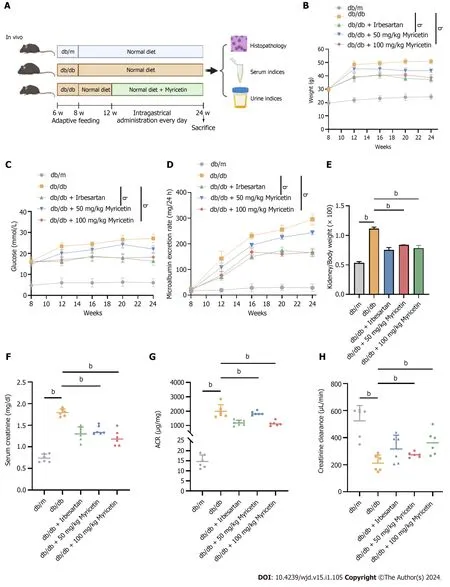
Figure 1 Myricetin alleviated the kidney injuries of diabetic nephropathy mice. A: Timeline of in vivo assay;B: Body weights;C: Blood glucose levels;D: 24 h-microalbumin levels;E: Kidney/body weight ratios;F: Serum creatinine levels;G: Albumin-to-creatinine ratios;H: Creatinine clearance values.ACR: Albuminto-creatinine ratio.bP < 0.05.
Microalbuminuria is recognized as the earliest clinical indicator in the initial stages of DN.Therefore,we assessed the kidney/BW index,serum creatinine,creatinine clearance,and uACR following 12 wk of myricetin treatment.In comparison to db/m diabetic mice,the db/db diabetic mice exhibited significantly higher levels of serum creatinine,kidney/BW index,and uACR at 24 wk (P< 0.01;Figure 1E-G).The db/db mice demonstrated a reduced clearance of creatinine compared to the control mice (P< 0.01;Figure 1H),indicating further evidence of diabetic renal pathological damages.Following a 12-wk treatment with either 100 mg/kg or 50 mg/kg myricetin,the db/db+myricetin group displayed significant decreases in kidney/BW,serum creatinine and uACR,and a notable enhancement in the clearance of creatinine compared to the db/db group (P< 0.01;Figure 1E-H).Thus,these data indicated that myricetin treatment alleviated the kidney injuries of DN mice.
Myricetin ameliorated the renal histopathological changes of DN mice
We conducted histological analyses of the kidney using HE staining and PAS staining to further evaluate the therapeutic effect of myricetin in DN mice.Notably,DN mice exhibited distinct pathological kidney alterations,including glomerular mesangial cell proliferation,thickening of capillary basement membranes,and increased vacuolation of renal tubules (Figure 2A and B).Importantly,the renal tubular damage and expansion of mesangial matrix were significantly more serious in DN mice than in the control group (P< 0.001).The administration of myricetin resulted in a significant decrease in the renal tubular damage score and a reduction in the area of the mesangial matrix in db/db mice compared to the control group.Additionally,there was a notable increase in the expressions of KIM-1 and NGAL in the kidney tissues of db/db mice,which was reversed in the db/db+myricetin mice,particularly in the high-dose subgroup (Figure 2C and D).Taken together,these findings suggested that myricetin treatment effectively ameliorated the renal histopathological alterations in db/db mice.
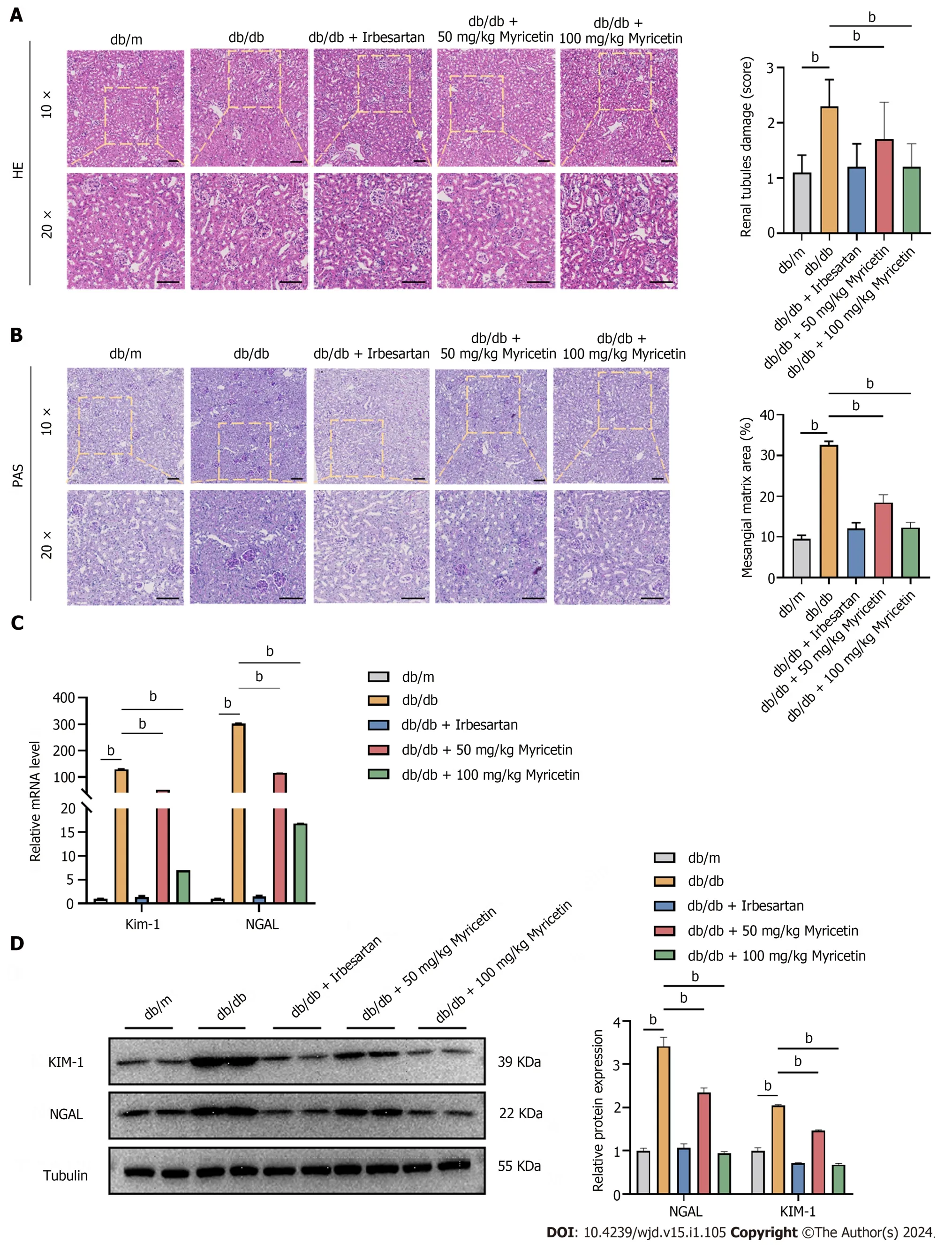
Figure 2 Myricetin ameliorated the renal histopathological changes of diabetic nephropathy mice. A: Hematoxylin and eosin staining showing renal tubule damage analysis (left and right) of kidneys;B: Periodic acid-Schiff staining (left) and mesangial matrix analysis (right);C: Kidney injury molecule-1 (KIM-1) and neutrophil gelatinase associated lipocalin (NGAL) levels by reverse transcription-PCR;D: NGAL and KIM-1 Levels determined by western blotting.Scale bar: 100 μm.HE: Hematoxylin and eosin;PAS: Periodic acid-Schiff;KIM-1: Kidney injury molecule-1;NGAL: Neutrophil gelatinase associated lipocalin.bP < 0.05.
Myricetin ameliorated inflammatory infiltration and renal fibrosis in DN mice
We used F4/80,a surface marker of M1-type macrophages,to stain the renal tissues to investigate the potential of myricetin in regulating renal function.Notably,an obvious infiltration of macrophage inflammation was observed in the kidney tissues of db/db mice when compared to the control group.However,the administration of myricetin significantly mitigated the infiltration of inflammation in the renal tissues (Figure 3A).Furthermore,the serum levels of M1 inflammatory factors were found to be up-regulated in db/db mice in comparison to db/m mice.Conversely,there was a significant decrease in the levels of IL-10,an M2 inflammatory factor,in db/db mice (Figure 3B and C).The administration of myricetin,particularly at a dosage of 100 mg/kg,resulted in a significant reduction in M1 inflammatory factors at both the mRNA and protein levels.Additionally,there was a notable increase in the expression of IL-10 following the administration of myricetin.

Figure 3 Myricetin inhibited inflammation factors and fibrosis in the renal tissue of diabetic nephropathy mice. A: Immunofluorescent staining of F4/80 protein;B: Tumor necrosis factor-alpha (TNF-α),interleukin (IL)-6,IL-1β,and IL-10 mRNA levels;C: Serum TNF-α,IL-6,IL-1β,and IL-10 Levels;D: Immunofluorescent staining of collagen-1a1 (Col1a1) protein;E: Reverse transcription-PCR analysis of Col1a1 and alpha-smooth muscle actin (α-SMA) mRNAs;F: Western blotting analysis of Col1a1 and α-SMA proteins;G: Masson’s trichrome staining (left) and renal fibrosis analysis (right);H: Sirius-red staining (left) and fibrosis analysis (right).TNF-α: Tumor necrosis factor-alpha;α-SMA: Alpha-smooth muscle actin;IL: Interleukin;Col1a1: Collagen-1a1.bP < 0.05.
Given that prolonged inflammatory infiltration triggers the activation of immune cells such as fibroblasts and myofibroblasts,which are involved in collagen synthesis and deposition and ultimately lead to fibrosis,we assessed the extent of renal fibrosis by using Col1a1 antibody staining of renal tissues.It was observed that db/db mice exhibited a higher percentage of Col1a1-positive region compared to db/m mice.Furthermore,the administration of myricetin resulted in a significant decrease in the percentage of the Col1a1-positive region (P< 0.001;Figure 3D).Additionally,we measured the levels of Col1a1 and α-SMA in the renal tissues.It was found that the fibrosis marker genes Col1a1 and α-SMA were significantly up-regulated in db/db mice,but not in those treated with myricetin,particularly in the high-dose subgroup (Figure 3E and F).Compared with db/m mice,db/db mice had significantly more fibrosis based on Masson’s trichrome staining and Sirius-red staining,while db/db mice treated with myricetin showed reduced fibrosis in their renal tissues (Figure 3G and H).Collectively,these data indicated that the myricetin treatment efficiently reduced inflammatory factor infiltration and occurrence of renal fibrosis in the db/db mice.
Myricetin switched the macrophage phenotype in the renal tissue of db/db mice
As shown in Figure 4,CD86 and CD206 were used as surface markers to identify the distinct polarized phenotypes of macrophages.The analysis of the polarized phenotypes of renal macrophages across the various groups of mice revealed a significant increase in CD86+macrophages in the kidneys of db/db mice compared to the control mice.Conversely,the number of CD206+macrophages was significantly reduced,indicating a bias towards M1 macrophage polarization in the kidneys of DN mice fed a high-fat diet.Following the administration of myricetin,a notable decrease in macrophage polarization of CD86+and an increase in macrophage polarization of CD206+were observed.This effect was particularly significant at higher doses and indicated that myricetin promoted the transition of macrophages from the M1 to the M2 phenotype,thereby mitigating the inflammatory effects.Notably,no significant disparity in the expressions of CD86+and CD206+macrophages was observed between the db/m group and the db/db+myricetin group.Thus,our results suggested that myricetin may have switched the phenotypes of macrophages in the renal tissue of db/db mice.
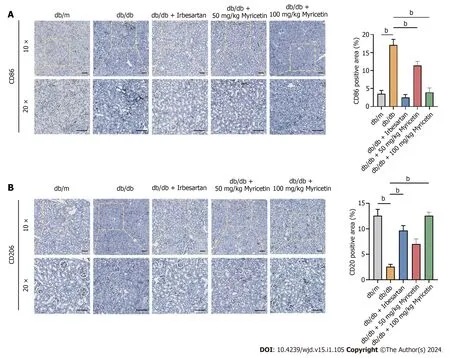
Figure 4 Myricetin switched the phenotype of macrophages in renal tissues of db/db mice. A and B: Immunofluorescent staining of CD86 protein (A) and CD206 protein.Scale bar: 100 μm.bP < 0.05.
High glucose induced M1-type macrophage polarization of RAW 264.7 cells
In order to validate the regulation of myricetin against kidney injury of DN,we built a cell model using RAW 264.7 macrophages exposed to high glucose concentrations.Flow cytometric analysis was conducted to assess the expression of CD86 and CD206.The results revealed a higher prevalence of M1 macrophages in cultures with high glucose concentrations (25 mM and HG) as compared to M2 macrophages,while no significant difference was observed in the lowglucose (5.5 mM) culture condition (Figure 5A).Under the stimulation of HG,it was observed that the abundance of M1 macrophages peaked at 24 h,and their polarization decreased with prolonged exposure time (Figure 5B).Similarly,when RAW 264.7 cells were induced with HG,the highest level of nitric oxide synthase (NOS) activity was observed at 24 h (Figure 5C and D).Furthermore,a significant increase in the expression and secretion of M1 inflammatory factors was observed in cells stimulated with HG,while the levels of IL-10 and Arg-1 were significantly reduced (Figure 5E and F).
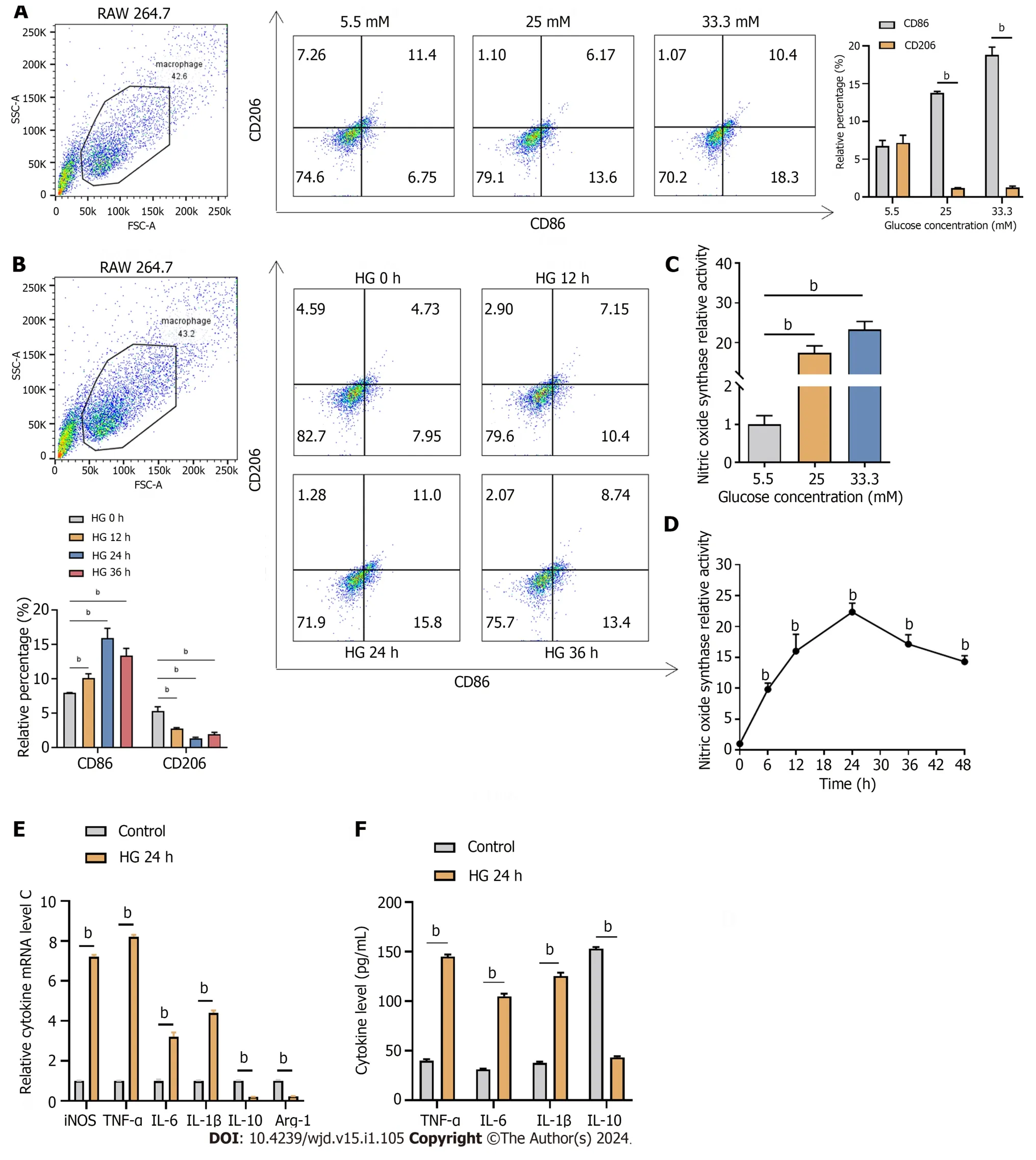
Figure 5 High glucose induced the M1 macrophage polarization of RAW 264.7 cells. A and B: Flow cytometry analysis of RAW 264.7 macrophages labeled with CD86 and CD206 exposed to different concentrations of glucose (A) and to 33.3 mmol/L glucose for different times (B);C and D: Inducible nitric oxide synthase (iNOS) levels induced by different concentrations of glucose (C) and by 33.3 mmol/L glucose for different times (D);E and F: Relative cytokine mRNA (E) and protein (F) levels of iNOS,tumor necrosis factor-alpha,interleukin (IL)-6,IL-1β,IL-10,and arginase-1 after exposure to 33.3 mmol/L glucose for 24 h detected by reverse transcription-PCR (E) and western blotting (F).Arg-1: Arginase-1;TNF-α: Tumor necrosis factor-alpha;IL: Interleukin;iNOS: Inducible nitric oxide synthase;HG: High-glucose.bP < 0.05.
Myricetin regulated polarization of RAW 264.7 cells under the HG condition
As shown in Figure 6A,a concentration gradient of myricetin at 12.5 μM,25 μM,and 50 μM was administered to the cells for 24 h.Flow cytometry analysis revealed that 25 μM myricetin exhibited the most potent inhibitory effect on M1-type polarization of the RAW 264.7 cells.The average percentage of M1-type macrophages was 6.56%,whereas the control group exhibited a percentage of 7.72% (Figure 6B).Furthermore,25 μM myricetin significantly suppressed the NOS activity of RAW 264.7 induced by HG (P< 0.001;Figure 6C).Furthermore,our results revealed that treatment with 25 μM myricetin significantly decreased the expressions of iNOS,TNF-α,IL-6,and IL-1β and increased the levels of IL-10 and Arg-1 (Figure 6D and E).Collectively,these data demonstrated that myricetin effectively modulated the polarization of RAW 264.7 macrophages from M1 to M2 under HG stimulation.
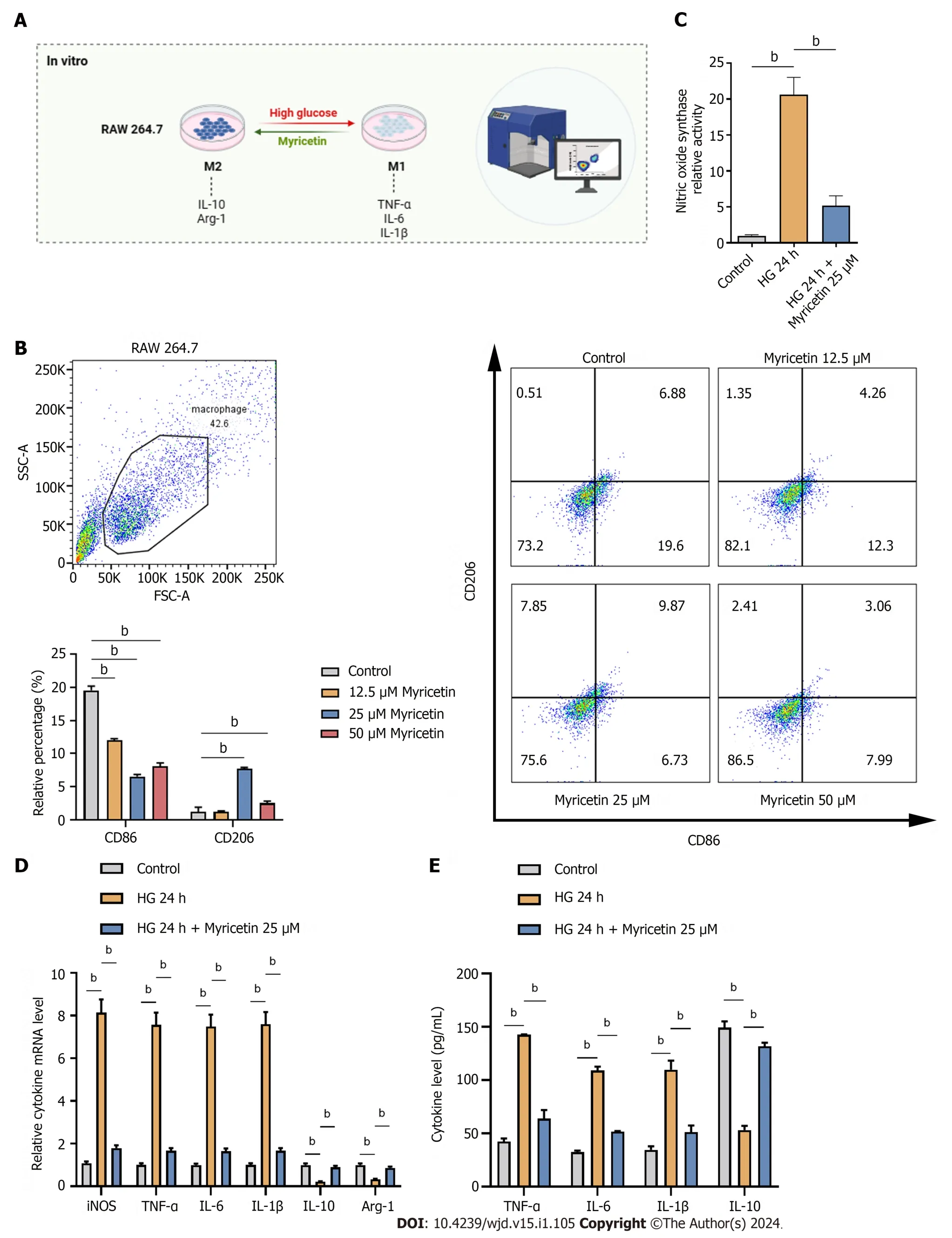
Figure 6 Myricetin regulated the polarization of RAW 264.7 cells to M2-type induced by high glucose. A: In vitro assay;B: Flow cytometry analysis of CD86-labeled and CD206-labeled RAW 264.7 macrophages induced with 33.3 mmol/L glucose and different concentration of myricetin;C: Levels of inducible nitric oxide synthase (iNOS) induced by 33.3 mmol/L glucose and after treatment with 25 μM of myricetin detected by ELISA;D and E: Levels of iNOS,tumor necrosis factor-alpha,interleukin (IL)-6,IL-1β,IL-10 and arginase-1 mRNAs (D) and proteins (E) induced with 33.3 mmol/L glucose and after treatment with 25 μM of myricetin detected by reverse transcription-PCR (D) and western blotting (E).Arg-1: Arginase-1;TNF-α: Tumor necrosis factor-alpha;IL: Interleukin;iNOS: Inducible nitric oxide synthase;HG: High-glucose.bP < 0.05.
Bioinformatics analysis of potential targets and pathways related with DN and myricetin
As shown in Figure 7A,a total of 3699 genes associated with DN were obtained from GeneCards and OMIM.The 43 genes that were linked to both myricetin and DN are presented in Venn diagram (Figure 7A).Subsequently,a PPI network comprised of these 43 potential targets was generated using the STRING database and visualized using Cytoscape 3.7.2 (Figure 7B).The PPI network revealed that Akt,TNF,and EGFR were the top three protein targets in immune and inflammatory signaling (Figure 7C).GO enrichment analysis revealed that myricetin treatment was associated with cellular response to oxidative stress,chemical stimulation,and protein kinases (Figure 7D).Additionally,KEGG pathway analysis indicated that myricetin primarily improved DN through the PI3K-Akt signaling pathway (Figure 7E and F).To further investigate this interaction,we used Autodock 4.2.6 to dock myricetin with Akt and PI3K,and subsequently performed a docking simulation using PyMOL 2.2.0 and Discovery Studio Client v19.1.0 (Figure 7G-H).Binding energy analysis indicated that myricetin exhibited a robust binding ability with Akt (-6.31 kcal/mol) and PI3K (-8.31 kcal/mol) (Figure 7I).Taken together,these results implied that the PI3K-Akt pathway served as a potential target in the protective mechanism of myricetin against kidney injury of DN mice.
Myricetin regulated polarization of RAW 264.7 cells through the PI3K-Akt pathway
We conducted additional experiments to validate the role of myricetin in regulating Akt kinase activity,thereby influencing macrophage polarization and cytokine secretion.Expression of the M1-type marker CD86 was significantly increased while the expression of the M2-type marker CD206 was significantly decreased compared to RAW 264.7 cells treated with myricetin alone (P< 0.001;Figure 8A).Our results indicated that myricetin induced a significant increase in Akt phosphorylation,while both LY294002 treatment and the HG condition inhibited Akt phosphorylation (Figure 8B).In accordance with prior data,we observed the up-regulation of M1 inflammatory factor-related genes in response to the HG condition and the administration of myricetin induced a notable decrease in the expression of these factors.However,the co-administration of LY294002 and myricetin to RAW 264.7 cells did not trigger the down-regulation of M1-related inflammation factors' expression (Figure 8C and D).Thus,our data indicated that myricetin may have regulated the macrophage polarizationviathe PI3K-Akt signaling pathway.
DISCUSSION
The worldwide prevalence of DM constitutes a pervasive metabolic disorder that is accompanied by a wide range of public health challenges.Projections indicate that by the year 2035,the number of individuals affected by this condition will reach 600 million[32,33].The sustained elevation of blood glucose levels over an extended period of time gives rise to various well-established chronic complications affecting multiple organs,such as the heart,kidneys,nerves,and retinas.Among these complications,DN is the most frequently occurring chronic microvascular complication,and it has been identified as the primary cause of ESRD,disability,and mortality[5,19].According to research,chronic hyperglycemia has been found to impact various kidney cell types and lead to progressive renal failure.
Currently,the only effective treatments available for ESRD patients are dialysis and transplantation.However,dialysis does not halt progression of the disease and the availability of donor kidneys is limited.Strategies for DN primarily focus on the control of blood glucose,with few effective therapies available for DN patients.Thus,there is an urgent need to develop novel and efficacious therapies.The molecular mechanism underlying DN is highly intricate,involving various metabolic disorders and pathways such as ferroptosis[34],oxidative stress[35],apoptosis[35],immune response and inflammatory-related pathways[36-38].It is widely acknowledged that inflammation plays a pivotal role in the progression of DN.Notably,renal inflammation has been demonstrated to contribute to the development of DN.Additionally,abnormal levels of IL-6,IL-18,and IL-1 have been identified as significant points to the development of DN[39,40].Thus,the investigation of novel therapeutic approaches for DN now places significant emphasis on the pharmaceutical agents that specifically target inflammation.
The observed anti-diabetic activity of flavonoids has boosted their potential as therapeutic agents for DM and its complications.Indeed,it has been demonstrated that application of quercetin led to a reduction in blood glucose levels in a diabetes animal model induced by STZ[41].More recently,it has been reported that kaempferol and myricetin combination treatment is promising in diabetes rats,due to their modulation of levels of glucose,inflammation,lipids and liver enzymes[42].Another study has further demonstrated that DM could be alleviated by myricetin aloneviaits effects on normalizing the profile of intestinal flora[43].The application of compounds in these contexts has collectively demonstrated the ability of a natural product to improve glucose levels and inflammatory cytokine levels in diabetic rats.
Our current findings indicate that the administration of myricetin at doses of 50 mg/kg or 100 mg/kg partially improved glucose levels,kidney/BW index,serum creatinine,creatinine clearance,and uACR in db/db mice.Furthermore,histopathological analysis revealed that myricetin significantly alleviated the DN pathological injury of renal tissue in mice.The administration of myricetin resulted in a reduction in inflammatory factors’ infiltration of kidney tissues and a decrease in the proportion of type M1 macrophages.Additionally,the renal fibrosis of DN mice was improved,as evidenced by a significant decrease in the accumulation of Col1a1 and α-SMA in DN mice treated with myricetin.These findings align with previous research and provide further validation of the role of myricetin in inhibiting the pathological progression of DN mice.
Importantly,myricetin not only plays a vital role in DN but also decreases migration of retinal pericytes[44],restores impaired motor and sensory functions[45],and enhances diabetic wound repair[46].To our knowledge,only one crosssectional population clinical study (consisting of 24138 subjects,among which 1357 had type 2 DM) has shown that myricetin intake might lower the prevalence type 2 DM and extend the period until other clinical treatments become necessary[47].Other studies have shown thatAbelmoschus manihotcapsule containing myricetin could be useful in decreasing proteinuria,blood creatinine and blood urea nitrogen in kidney patients[48,49].
Given the emphasis on the role of inflammation in the development of DM and its complications,our study aimed to investigate the mechanism by which myricetin regulates the serum levels of TNF-α,IL-6,and IL-1β in DN mice.We observed that myricetin exhibited anti-inflammatory effects by reducing inflammatory factors associated with M1.To further understand this mechanism,we performed experiments using RAW 264.7 cells and found that treatment with 25 μM myricetin effectively mitigated cell injury induced by the HG condition (specifically 33.3 mM glucose).The results indicated that myricetin exerted an inhibitory effect on the polarization of RAW 264.7 macrophages towards the M1-type and significantly suppressed the iNOS activity induced by HG.Furthermore,treatment with myricetin led to a significant downregulation of M1-dependent inflammatory factors,as evidenced by decreased IL-10 and Arg-1 expression and secretion.These findings suggested that myricetin modulated the polarization of RAW 264.7 macrophages towards the M2-type,which was implicated in the progression of DN.
Several proteins and pathways have been documented as capable of inducing alterations in the polarization of RAW 264.7 macrophages,such as the PI3K-Akt,Notch1,NF-κB,MAPKs,and JNK/STAT3 signaling pathways[50-53].In the context of a diet-induced non-alcoholic steatohepatitis model in mice,myricetin was able to mitigate inflammatory hepatitis and fibrosis by modulating macrophage polarization.This was achieved through the inhibition of NF-κB signaling and STAT3 activation,as well as the phosphorylation of the signal transducer[54].Furthermore,the administration of flavonoids showed ability to mitigate inflammation in lipopolysaccharide-stimulated RAW 264.7 cells through involvement of the NF-κB and MAPK pathways[55].These data in the literature stimulated our interest to investigate the mechanism by which myricetin modulates macrophage polarization.
Our bioinformatics analysis revealed that Akt was the primary target protein associated with immune response and inflammatory signaling pathways in DN mice and cultured cells.Additionally,our results indicated that myricetin had significant binding affinity with both Akt and PI3K.It has been reported that the PI3K/Akt pathway activates NF-κB through Akt phosphorylation,leading to the transcription of numerous inflammatory genes and receptors for advanced glycation products,and thereby promoting the production of cytokines that induce inflammation[56].The association between up-regulated cytokines,including TNF-α,IL-1β,IL-1,IL-18,and DN and other diseases has been extensively documented[11,12].Furthermore,the activation of the PI3K/Akt pathway has been identified as a critical factor in the polarization,migration,proliferation,and survival of macrophages[57].The PI3K/Akt signaling pathway,through mTORC1,can regulate a macrophage's effector response,thereby modulating innate immune responses and macrophage polarization[58].Genes related to PI3K/Akt signaling pathway deletion,including SHIP and PTEN,significantly inhibit the production of pro-inflammatory cytokines by enhancing the M2 macrophage phenotype[59].Activation of the PTEN/PI3k/Akt pathway was reported to mediate the polarization of M2 macrophages among RAW 264.7 cells and in emphysematous mice[60].
In this study,we specifically inhibited the phosphorylation of Akt in myricetin-treated HG-induced RAW 264.7 cells,and in agreement with previous findings we found that the polarization of RAW 264.7 cells to M2-type was blocked;this indicated that myricetin can regulate the polarization of macrophages through the PI3K/Akt pathway and thus affect the secretion of cytokines (Figure 9).However,the PI3K/Akt pathway is well known for its ability to modulate various proteins and pathways,prompting the next question of interest: whether or not the function of myricetin in DN is due to its activation of Akt or other yet-unidentified proteins?
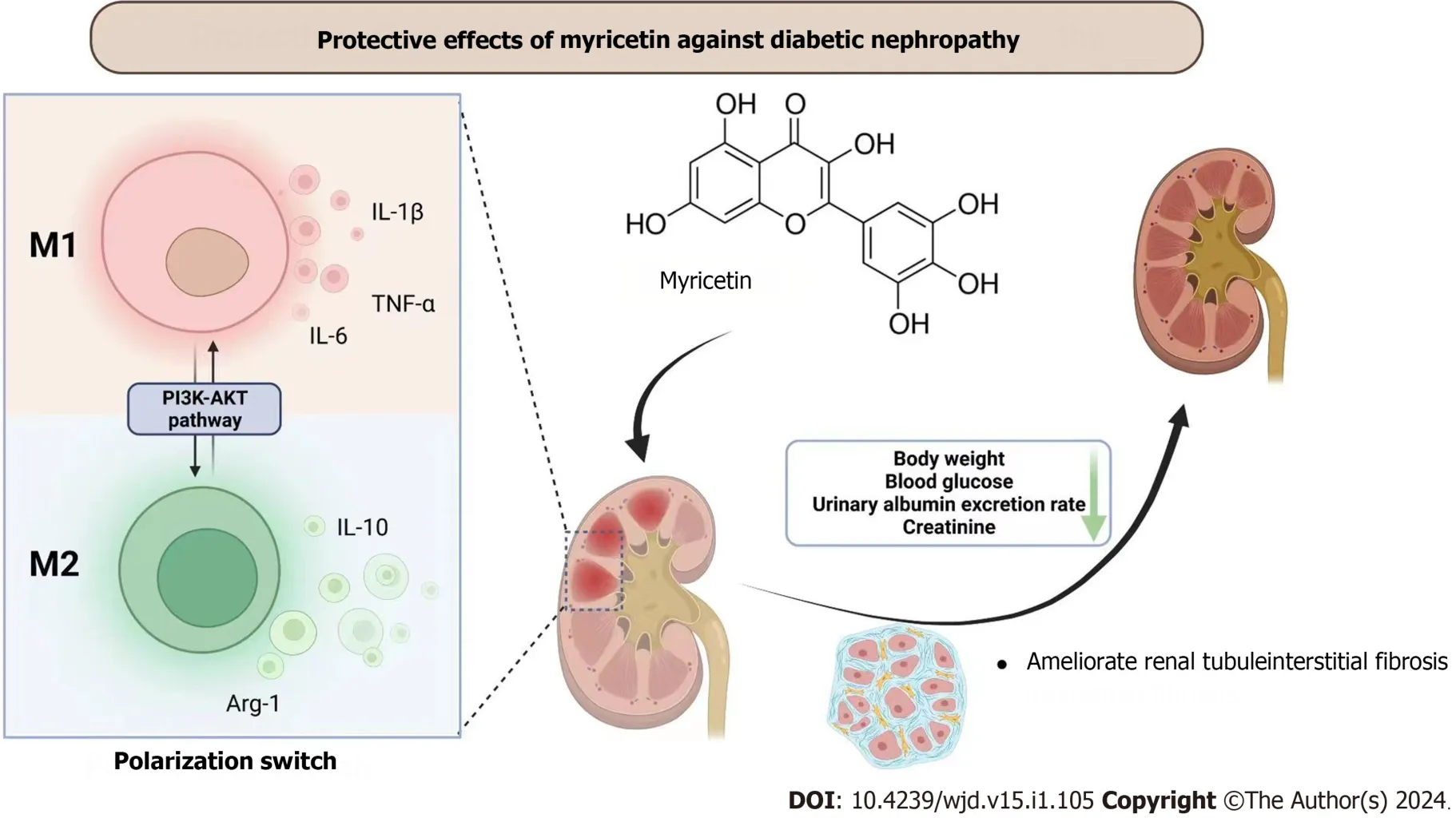
Figure 9 Overview of protective effects of myricetin against diabetic nephropathy. Myricetin can regulate the polarization of macrophages through the PI3K/Akt signaling pathway to ameliorate the injuries of kidneys in mice with diabetic nephropathy.Arg-1: Arginase-1;TNF-α: Tumor necrosis factor-alpha;IL: Interleukin.
CONCLUSION
The results from this study suggest that high concentrations of myricetin have the potential to impede M1-type polarization of macrophages through the PI3K-AKT signaling pathway.Simultaneously,it exhibits promising efficacy in the treatment of renal injury,inflammation,and fibrosis in mice with DN.Our study provides a proof-of-concept of the function of myricetin against the progress of kidney injury induced by DM and provides more fundamental data for the development of myricetin as a bona fide treatment for diabetics.
ARTICLE HIGHLIGHTS
Research background
Diabetic nephropathy (DN) is frequently observed as a chronic microvascular complication linked to end-stage renal disease,and it constitutes a significant contributor to both disability and mortality worldwide.Current therapies merely delay renal injury by controlling metabolic disturbances that occur in the early stage and,as such,there remains an urgent need to seek out and develop new drugs for clinical use.To this end,we have performed focused research on the Chinese patent medicineAbelmoschus manihotfor its ability to decrease proteinuria in patients with DN.
Research motivation
Previous studies have indicated that myricetin possesses the potential to mitigate the pathological alterations observed in renal tissues of DN patients and models.Nevertheless,the precise molecular mechanism through which myricetin influences the progression of DN remains uncertain.
Research objectives
To investigate the effects of myricetin on DN and explore the underlying mechanisms of its potential therapeutic effects.
Research methods
Db/db diabetic mice were administered myricetin and effects on blood and urine indexes and renal tissue pathology were assessed.Additionally,the RAW 264.7 cell line was cultured in high glucose conditions and then exposed to the PI3K/Akt inhibitor LY294002.In both thein vivoandin vitrosettings,quantification of various inflammation factors’ levels was conducted using western blotting,real-time qPCR and ELISA.
Research results
In the db/db mice,myricetin had a mitigating effect on renal dysfunction and fibrosis,including kidney injury markers kidney injury molecule-1 and neutrophil gelatinase associated lipocalin and inflammatory cytokine-related factors.In the RAW 264.7 cells,myricetin treatment effectively inhibited the up-regulation of tumor necrosis factor-alpha,interleukin (IL)-6,and IL-1β and modulated M1-type polarization.Molecular docking and bioinformatic analyses revealed that Akt was the target of myricetin.The protective effect of myricetin was nullified upon blocking the polarization of RAW 264.7viainhibition of PI3K/Akt activation using LY294002.
Research conclusions
Myricetin effectively mitigates kidney injury in DN mice through the regulation of macrophage polarizationviathe PI3K/Akt signaling pathway.
Research perspectives
Myricetin represents a promising therapy in treating DN.
ACKNOWLEDGEMENTS
We acknowledge the SwissTargetPrediction,GeneCards,OMIM,STRING and PubChem databases for providing platforms for uploading their datasets with meaningful information,and thank all animals involved in this study who gave their lives for the advancement of human health.
FOOTNOTES
Co-first authors:Wei-Long Xu and Pei-Pei Zhou.
Co-corresponding authors:Xiao Wu and Jiang-Yi Yu.
Author contributions:Xu WL and Yu JY designed the study;Xu WL and Zhou PP carried out the experiments;Tian T,Yu X,and Bao JJ contributed experiment assistance;Yu X,Bao JJ,and Zha M analyzed the data;Xu WL and Zhou PP generated the figures;Ni CR donated the myricetin natural product;Xu WL,Zhou PP,Yu JY,and Wu X drafted and revised the manuscript;Yu JY and Wu X conceived and supervised the study;All authors approved the final version of the article.Xu WL and Zhou PP contributed equally to this work as co-first authors.Xu WL and Zhou PP together completed the chief experiments,formation of figures,and writing of initial manuscript,which were the most important and indispensable part of this study.Especially,Xu WL designed the study.Yu JY and Wu X contributed equally to this work as co-corresponding authors.Yu JY and Wu X revised the manuscript,conceived and supervised the study to make the study better presented.Especially,Yu JY provided enough financial support in the progress of experiments and ensured all the journal’s administrative requirements.
Supported byNational Natural Science Foundation of China,No.82205025,No.82374355 and No.82 174293;Subject of Jiangsu Province Hospital of Chinese Medicine,No.Y21023;and Forth Batch of Construction Program for Inheritance Office of Jiangsu Province Famous TCM Experts,No.[2021]7.
Institutional animal care and use committee statement:Pathogen-free environments andad libitumfeeding were ensured for all animals.In accordance with its Ethics Committee,Jiangsu Province Hospital of Chinese Medicine approved the procedures for care and use of animals [QK-20200408-001].Full compliance with all applicable institutional and governmental regulations regarding animal ethics was maintained throughout the study.
Conflict-of-interest statement:The authors declare that there were no commercial nor financial relationships that could be considered as potential conflicts of interest in the research.
Data sharing statement:The raw data are available upon reasonable request from the corresponding author.
ARRIVE guidelines statement:The authors have read and the ARRIVE guidelines,and the manuscript was prepared and revised according to the ARRIVE guidelines.
Open-Access:This article is an open-access article that was selected by an in-house editor and fully peer-reviewed by external reviewers.It is distributed in accordance with the Creative Commons Attribution NonCommercial (CC BY-NC 4.0) license,which permits others to distribute,remix,adapt,build upon this work non-commercially,and license their derivative works on different terms,provided the original work is properly cited and the use is non-commercial.See: https://creativecommons.org/Licenses/by-nc/4.0/
Country/Territory of origin:China
ORCID number:Xiao Wu 0000-0002-3377-5713;Jiang-Yi Yu 0000-0001-7159-5396.
S-Editor:Lin C
L-Editor:A
P-Editor:Cai YX
 World Journal of Diabetes2024年1期
World Journal of Diabetes2024年1期
- World Journal of Diabetes的其它文章
- Nutrition interventions and clinical outcomes of pregnant women with gestational diabetes mellitus: More than meets the eye
- Individualized intensive insulin therapy of diabetes: Not only the goal,but also the time
- Urinary exosomal microRNA-145-5p and microRNA-27a-3p act as noninvasive diagnostic biomarkers for diabetic kidney disease
- Body composition and metabolic syndrome in patients with type 1 diabetes
- Investigating the relationship between intracranial atherosclerotic plaque remodelling and diabetes using high-resolution vessel wall imaging
- Heterogeneously elevated branched-chain/aromatic amino acids among new-onset type-2 diabetes mellitus patients are potentially skewed diabetes predictors
